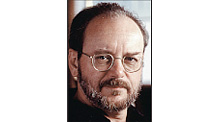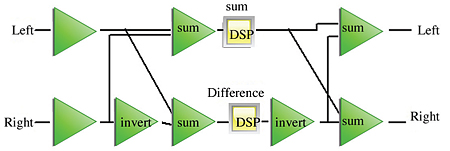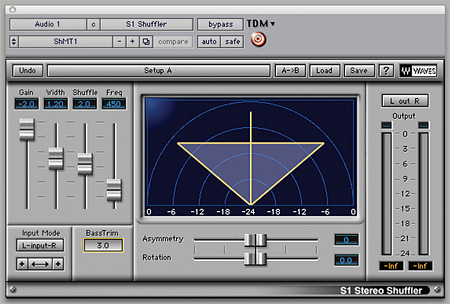Sum and Difference Signals Can Equal Fun

Alert readers may recall that a couple of months back I finished off a group of columns about the LFE Channel and Subwoofers with one about the phenomenon called "envelopment." In that column ("Experiencing Envelopment: The Secret Sauce of Stereo," Jan. 4, 2012), I discussed a device called a Shuffler, a device that converts Left and Right signals into Sum and Difference signals and vice versa. I showed a little about how we use it to add envelopment to our mixes and I mentioned that numerous software manufacturers offered shufflers for sale as plug-ins.
A number of you have written me wanting to know more about the shuffler and the Sum and Difference signal pair, so I thought I'd delve into this in a little more detail. Thanks for writing.
IN REVIEW
The first thing to keep in mind is that we are talking about a pair of signals here, not a single mono signal. This processing approach will do little for a mono track except possibly cancel or screw it up it if you're careless. So, mostly we're talking about stereo pairs of tracks with signals that are related but not identical, which is why they're called stereo tracks. They can be mixes, they can be stems or they can be the stereo capture of a single source or array in a room, (think of a stereo mic on a lead vocal or stereo drum overheads, for instance).
When we do this sort of signal processing, we actually need two shufflers in series, just as I presented in my last column on this:
Note that we start with a stereo L/R pair of signals and also end with such a stereo L/R pair.
Most commercial shufflers are exactly like this—you don't have to buy two of them!
SIGNAL PROCESSING IN SUM & DIFFERENCE

Fig. 1: A pair of shufflers in series with signal processing available on sum and difference channels in between the shufflers. Once we have this pair of shufflers in place with signal processing inserted, we can do an array of really interesting things that are not particularly obvious but can yield some great improvements and often solve problems that we regarded as impossible when working in plain old stereo. To do this, we have to start thinking about the nature of the Sum and the Difference signals, and their aesthetics.
The Sum signal (also known in some circles as the Mid signal) can be thought of as the sounds we are directly listening to and focusing on. The Difference signal (aka Side signal), can be thought of as an ambience signal, everything else in the mix that we aren't directly paying attention to but which affect our perception of the mix in interesting and subliminal ways. "Envelopment," as I discussed a couple months back, is a key subliminal effect.
So here's the thing. What signal processing would you like to do on the stuff you are focusing on directly, and why? And what signal processing would you like to do on the subliminal ambient stuff? Why?
We have three families of signal processing to consider and even possibly combine: EQ (where we change the spectrum); compression (where we change the envelope, or loudness over time); and reverberance/time delay (where we change the relative time and decay of sound over time).
When you get into this, you'll find that there is a lot that you can do, as I hinted above. And it's quite different, in outcome, than the normal signal processing we do on mono tracks or stereo stems. In the remaining space here, I'll take a very quick look at time domain, or reverberance; stuff which expands on the envelopment effects we considered in that earlier column.

A Schuffer converts Left and Right signals into Sum and Difference signals and vice versa.IN DETAIL
The most basic thing you can do with time is similar to a signal processing trick I use a lot called a "spreader." You simply delay the Difference signal by a small amount (up to about 25 ms.). What will happen is that the mix will gain some depth, while the Sum signal will tend to become a little more solid and appear to be a little "closer" to you. You don't want to push this, but for the right mix or stem, it can really help things. Always check the mono sum, however, and be alert to comb filtering effects (pitched hissing sounds). You may need to also adjust the gain of the Difference signal. You could also try delaying the Sum signal instead, which will give you a different effect, that of the center image receding into the ambience but staying just as loud. It's a little weird, but might do some good for you in some cases. It's worth trying, certainly.
You can also add reverb to the Difference signal or send the Difference signal to your house reverb through an aux bus. The payoff here is that you add reverberance without changing the amount of reverb on the direct sounds that are primarily in the Sum signal.
So, both of these techniques allow you to add the quality of reverberance to your stereo pair without making the primary (Sum) sounds get swimmy or wet with reverberance. It can be a very handy trick. It's one I actually enjoy a lot.
Next month we will consider how you might equalize Sum and Difference signals, and also how you might use compression. Traditional stereo compression is terribly constrained by the need to stabilize the stereo image. In Sum and Difference mode, that constraint goes away, and you can have a lot more flexibility to deal with the individual needs of the "direct" and "ambient" components of a mix. It is some powerful medicine! I hope you can get to use it for fun and profit yourselves. I sure have!
Thanks for listening.
Dave Moulton's contribution to audio wisdom has been summarized as different! Oh, well. You can still complain to either his Sum or his evil twin Difference about anything at all on his website, www.moultonlabs.com.
Get the TV Tech Newsletter
The professional video industry's #1 source for news, trends and product and tech information. Sign up below.

